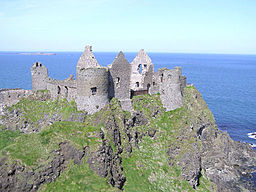Dunluce Castle: Difference between revisions
May09dream (talk | contribs) |
May09dream (talk | contribs) |
||
| Line 73: | Line 73: | ||
== External links == |
== External links == |
||
{{Commons category}} |
{{Commons category}} |
||
* [http://www.megalithicireland.com/ |
* [http://www.megalithicireland.com/Dunluce Castle.html Megalithic Ireland] |
||
* [http://www.ni-environment.gov.uk/places/monuments/dunluce.shtml Dunluce Castle] from the website of the [[Northern Ireland Environment Agency]] |
* [http://www.ni-environment.gov.uk/places/monuments/dunluce.shtml Dunluce Castle] from the website of the [[Northern Ireland Environment Agency]] |
||
Revision as of 00:27, 25 November 2010
| Dunluce Castle | |
|---|---|
| County Antrim, Northern Ireland | |
 | |
| Coordinates | 55°12′38″N 6°34′52″W / 55.21056°N 6.58111°W |
| Type | Castle |
| Site information | |
| Controlled by | Northern Ireland Environment Agency |
| Open to the public | Yes |
| Condition | In ruins |
| Site history | |
| Built | Late Middle Ages and 17th century[1] |
Dunluce Castle (Irish: Dún Lios, "strong fort") is a now-ruined medieval castle in Northern Ireland. It is located on the edge of a basalt outcropping in County Antrim (between Portballintrae and Portrush), and is accessible via a bridge connecting it to the mainland. The castle is surrounded by extremely steep drops on either side, which may have been an important factor to the early Christians and Vikings who were drawn to this place where an early Irish fort once stood.
Protected status
Dunluce Castle is in the care of the Northern Ireland Environment Agency. It is a Monument in State Care sited in the townland of Dunluce, in Coleraine Borough Council area, at grid ref: C9048 4137.[2] The earthworks, adjacent to Dunluce Castle, are a Scheduled Historic Monument, at grid ref: area of C905 412.[3]
History
In the 13th century Richard Óg de Burgh, 2nd Earl of Ulster, built the first castle at Dunluce.
It is first documented in the hands of the MacQuillin family in 1513. The earliest features of the castle are two large drum towers about 9 metres (30 ft) in diameter on the eastern side, both relics of a stronghold built here by the MacQuillins after they became lords of the district, the chieftain of which was known as Lord of the Route, in the late 14th century.
Later it became the home of the chief of the Clan MacDonnell of Antrim and the Clan MacDonald of Dunnyveg from Scotland. Chief John Mor MacDonald was the second son of Good John of Islay, Lord of the Isles, 6th chief of Clan Donald in Scotland. John Mor MacDonald was born through John of Islay's second marriage to Princess Margaret Stewart, daughter of King Robert II of Scotland. In 1584, on the death of James MacDonald the 6th chief of the Clan MacDonald of Antrim and Dunnyveg, the Antrim Glens were seized by Sorley Boy MacDonnell, one of his younger brothers. Sorley Boy took the castle, keeping it for himself and improving it in the Scottish style. Sorley Boy swore allegiance to James IV of Scotland and his son Ranald was made Randal MacDonnell, 1st Earl of Antrim by Queen Elizabeth.
Four years later, the Girona, a galleass from the Spanish Armada was wrecked in a storm on the rocks nearby. The cannon from the ship were installed in the gatehouses and the rest of the cargo sold, the funds being used to restore the castle. MacDonnell's granddaughter Rose was born in the castle in 1613.
At one point, part of the kitchen next to the cliff face collapsed into the sea, after which the wife of the owner refused to live in the castle any longer. According to a legend, when the kitchen fell into the sea only a kitchen boy survived, as he was sitting in the corner of the kitchen which did not collapse.
Dunluce Castle served as the seat of the Earl of Antrim until the impoverishment of the MacDonnells in 1690, following the Battle of the Boyne. Since that time, the castle has deteriorated and parts were scavenged to serve as materials for nearby buildings.
In popular culture
In 1973 the castle appeared on the inner gatefold of the multi-million selling Led Zeppelin album Houses of the Holy. Keanu Reeves's character makes reference to this in the comedy film Bill & Ted's Excellent Adventure when they travel back in time to meet Socrates. The castle also appeared in Jackie Chan's The Medallion (2001) when it provided an exterior setting for the "villains lair."
See also
References
Specific references:
- ^ Dunluce Castle from the website of the Northern Ireland Environment Agency
- ^ "Dunluce Castle" (PDF). Environment and Heritage Service NI — State Care Historic Monuments. Retrieved 2007-12-03.
- ^ "Dunluce" (PDF). Environment and Heritage Service NI — Scheduled Historic Monuments. Retrieved 2007-12-03.
General references:
- Culture Northern ireland
- Charles Johnston (1902). "Ireland, Historic and Picturesque". Project Gutenberg.
External links
- Castle.html Megalithic Ireland
- Dunluce Castle from the website of the Northern Ireland Environment Agency
